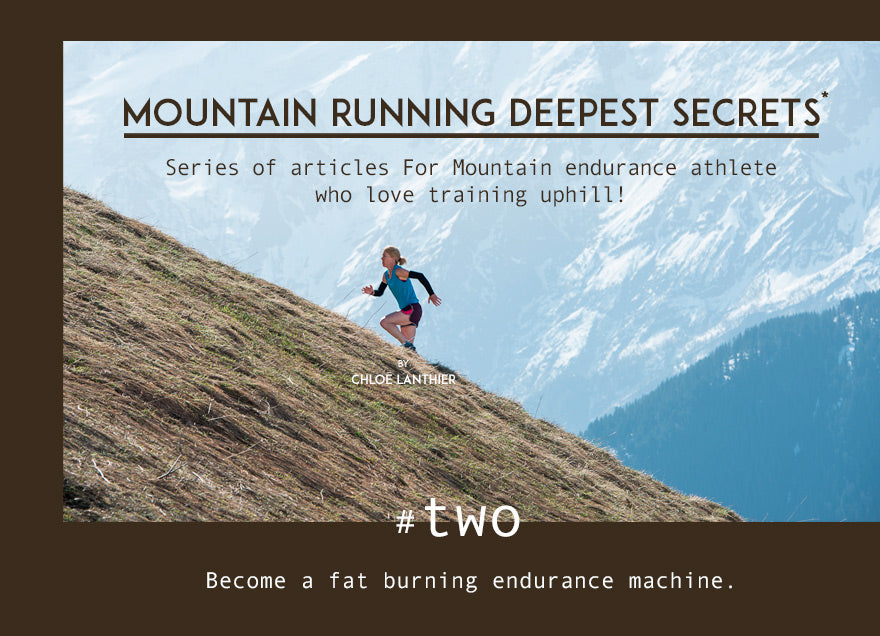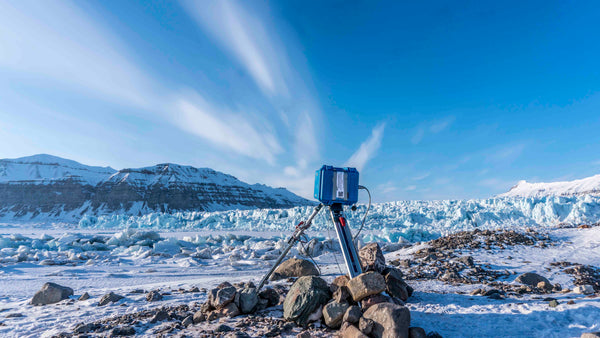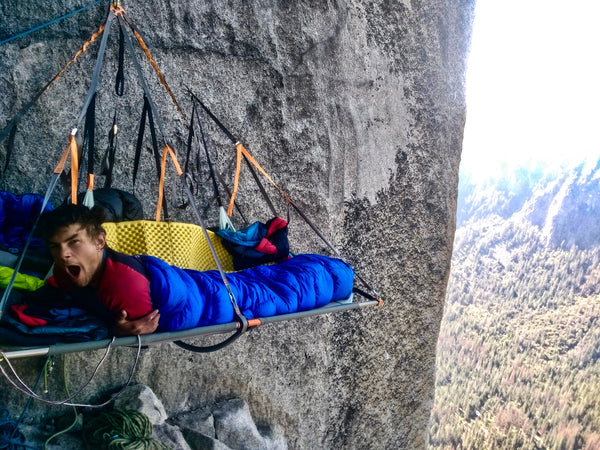Mountain running deepest secrets #TWO
December 04, 2017

* This is not about the latest gear, newest app or miracle diets. This article is for the ones of you who enjoy training in the mountains, love endurance and prefer moving uphill versus flat! I stayed away from jargon and scientific statistic to be straight to the point in a simple mater, so hopefully this article is easy to understand and to put into practice.
Becoming efficient at using fat as a main fuel is the diamond ring of any mountain endurance athlete: long term commitment & special care since very fragile.
Being able to move faster, for longer, in steeper terrain without the legs burning is the dream of every mountain athlete. That dream can become a reality, often overlooked it’s all in the training with some understanding of basic exercise physiology... lets start!
Crash course on muscle metabolism:
When you start exercising sugar burns first, fat is harder to access, you have to go through each energy system before you reach fat, the last one to be recruited. It can take 10 minutes for some, an hour for others and never for most!
Order we go through the energy system when we start exercising:
ATP-CP / blood glucose & muscle glycogen / glycogen & free fatty acids Fat is stored far from muscles and sugar is stored in the muscles (muscle glycogen). Endurance athlete burn lots of fat post exercise, especially after a full day of skinning uphill, a four hour x-country workout in Val Ferret, or a 3 hours mountain run with 1500m total vertical. Also with a more intense but shorter workout, example a 60 to 90 minutes of ski vertical training, uphill by the way!
sugar + fat = energy
Sugar is stored as blood glucose, muscle glycogen and a small amount as brain glucose.
Fat is inexhaustible. Sugar runs out quickly. To burn sugar you need fat and vice versa
You will notice when you start exercising, the first few minutes your breathing is higher so is the heart rate, after a few minutes all settles... you are going from ATP-CP to the glycogen process, which is more intense, when you get into the aerobic system, oxygen is available and heart rate slows down. One of the reason we warm-up!
Fat burning enzymes, a few things you need to know:
We’re not born with fat burning enzymes, we have to build them, but how? Need a good base of endurance fitness, a history with quality months of consistent training. The enzymes take around six to eight weeks to build, it’s called physiological adaptation, but your training needs to be based on endurance with some over distance training.
Fat burning enzymes are fragile they will go on strike if you exercise too hard, or too often, and if you are inconsistent with your training. The more consistent and smarter you are with your training the more efficient your enzymes will be: you will be able to exercise at higher intensity, maintain lower heart rate and still burn predominantly fat.
If you are inconsistent from day to day and week to week, or stop exercising for a few weeks, enzymes gets destroyed, they have big egos; you don’t use them, they disappear!
The more months & years of training you have you will be more able to use fat at higher intensity. You only burn fat if the workout is aerobic. The fitter you get and the smarter you are with you training you’ll be able to train at higher intensity but stick to fat as a main fuel.
Not every endurance athlete is efficient at using fat, it’s all in the training, the recovery (next article) and the lifestyle. For mountain endurance athletes the training needs to be specific to the terrain, climbing! It’s not by doing 3 workouts in the valley and one at higher elevation you will become a fat burning endurance machine!You need to put the distance in, workouts longer than 2 hours, with easy to moderate intensity. But we still have shorter workouts, 60 minutes, to fine tune speed for endurance and climbing strength & power.
When an athlete becomes efficient at using fat as the main fuel, since sugar reserved are limited for everyone, it can be saved for steeper terrain, or for last portion of a very long workout/day and during competition. You will notice the talented mountain athletes can maintain a very fast pace for some very long races, they are the formula 1 of fat burning engines!
When the intensity is short and very high, sugar is the main fuel and oxygen is not required, the anaerobic system kicks in when the aerobic metabolism can no longer meet the ATP demands of the muscles. The by-product is lactate production, the burning sensation in the legs and feeling an intense drop in energy. The only option is to slow down and fatigue will take over for the rest of the workout. Fatigues comes in when the pace is too fast for too long or to fast for the degree of the slope. The fatigue is due to a reduction of ATP output, that drop in ATP production is prompted by the accumulation of hydrogen ions along with lactate in the blood. In endurance event like ski mountaineering and mountain running, the athletes are most limited in their endurance ability to deal with this type of fatigue.
The burning sensation you feel in your legs.
The fitter and the more efficient an athlete is at using fat as the main fuel, with time he/she will be able to train at higher intensity and for longer distances while maintaining this physiological paradise! Your legs will feel strong for longer since you have more blood and oxygen available to the working muscles. One benefit, the by-product of fatigue is diminished and shows up more in extreme situations: multi-day mountain events, ski mountaineering races, ultra-running races or altitude training/events - less oxygen available.
An individual that has moderate fitness and starts climbing a hill ‘fast’, the feeling is ‘intense’, a very higher percentage of muscle glycogen will be use and very quickly he/she will have to slow down and probably walk for a big portion. Does not mean you can hike for 4 hours and climb 1500m that you are efficient at using fat as the main fuel.
How can I train to change my metabolism to be more efficient at using fat?
First you have to evaluate your training program, how many days a week do you get out, for how long, the terrain, the sport, any variation in intensity from day to day, any progression from week to week, any results from month to month?
The muscular and cardiovascular adaptation are tremendous when you start doing long, quality and regular over distance sessions. Walking uphill, stopping for 5 minutes to chat every 45minutes, and only once every 10 days won’t do it. Anything under two hours, usually is not long enough to stimulate the particular enzymes.
Also too much volume, too many hours in a week, won’t influence your metabolism in a positive way, the biggest mistake an endurance athlete can do. It’s all in the quality of each workout.
You need to divide your week and make sure you have one or two over distance and also a few endurance workouts, also never forget a shorter but quality vertical session. All this depends of your experience and fitness level, if unsure consult a qualified endurance coach. Lets look at the difference between each:
Endurance Training: up to 2 hours
This component is extremely important for developing and maintaining aerobic capacity, accomplished at low to moderate intensity. It accomplishes many things: It increases your body’s ability to consume oxygen (V02max), increases the size and the number of mitochondria in muscle cells, increases the size and numbers of blood capillaries, and improves aerobic enzymes for carbohydrate and fat metabolism. Endurance exercise improves your body’s ability to deliver the goods to your muscles so that they adapt, grow stronger, and become better at prolonged effort. You become more efficient at using fat as a fuel.
Over Distance (OD) Training: over 2hrs
Here lies the heart of training for long mountain distances. The greatest percentage of the total training volume is reserved to over distance. OD does not mean overdoing it! The difference between endurance and OD is the amount of time you spend training. For most OD workouts they usually exceeds 2-3 hours. Although the intensity is low at the beginning, it progresses throughout the session.
The volume becomes your intensity One gains mental toughness from OD training!
After three hours of running at the same pace, for example, your HR will be higher and you will experience more muscular fatigue. After adaptation and better fitness your heart rate won’t increase with time and your legs will feel better. You will be able to maintain the same pace from start to finish without having to slow down. The SECRET to optimum OD is in the physiological changes: Basically, there are two adaptations the body makes in response to OD training that you don’t get from endurance runs:
FIRST
training the body to increase it’s efficiency for releasing and burning free fatty acids over long distances, as enzymatic and hormonal changes in the muscles cells, which make it easier for fat to be utilized as fuel during longer workouts.
SECOND
improvement in the body’s circulatory characteristics in the peripheral muscles; the muscles that do the work in long intense sessions will move waste products away and bring new blood, oxygen, and fuel to the working muscles, your legs will stay fresh for longer!
The body will be able to function at higher intensities for longer periods without the debilitating effects.
A solid aerobic base is very important before you start OD training, I recommend a minimum of 3-5 months of solid endurance with some quality (speed) training. All depends of your fitness level. OD training does not mean moving slow or walking, a certain pace and consistency is required to have any benefits.
Understanding the training components
Each training components stimulates a particular adaptations of the muscle fibers and the energy systems. Focusing and proper progression for each components is crucial to be a well rounded mountain endurance athlete and is key to overall performance. Each defined in terms of relative time, intensity, and technical purpose is used to compose an efficient training plan.
Understanding the purpose of each training components will enhance the outcome of each training session:
Endurance.
Over distance
Speed
Strength & Power
Plus an extra components for mountain endurance athletes:
Vertical training (positive & negative!)
Since the body faces the extra battle against the force of gravity, these workouts increase strength, power, muscular endurance, and aerobic capacity all at once. Also, it recruits the specific muscles used for climbing:
hamstring, gluteus and calf.
Quality Vertical & over distance training are the two most overlooked and misunderstood aspect of mountain endurance training.
Get inspired, review your training regimen, remember it’s all about quality and consistency. You also need to love your backyard since the mountains become your playground and some workouts will have to be done very early in the morning or in the dark evenings, super romantic. It’s about a lifestyle more than training!
Give 100 % to quality training & recovery!
I have been training following these principles for more than 25 years, in three different mountain sports. It has enable me to maintain an edge with my speed for endurance. I’ve stayed away from overtraining and overuse injuries and I’ve learned very quickly it’s not the total volume but the quality of each workouts that will influence best my fitness for the mountains.
Enjoy the snow, the vertical and your fitness!
Stay in touch, email me your thoughts chloe@xtrainingschool.com
Get inspired!

Chloë is an elite multi-sport athlete with over two decades of experience competing around the world. Chloë is a consultant in sports rehabilitation & human performance teaching on an international platform. Sharing her passion, experience and knowledge is an integral part of her daily routine. In her free time, she loves skinning up mountains and skiing fresh powder. Canadian, she lives full time in Chamonix.
xtrainingschool.com
Next article: Mountain endurance training secrets: everything you need to know about fueling & hydration for better recovery.
Cover photo: Dylan Taylor
Share:
Comments will be approved before showing up.







